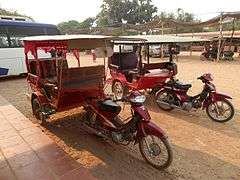Auto rickshaw
An auto rickshaw is a motorized version of the pulled rickshaw or cycle rickshaw. Most have three wheels and do not tilt. They are known by many terms in various countries including auto, baby taxi, pigeon, bajaj, chand gari, lapa, tuk-tuk, 3wheel or tukxi.

The auto rickshaw is a common form of urban transport, both as a vehicle for hire and for private use, in many countries around the world, especially those with tropical or subtropical climates, including many developing countries. As of 2019, Bajaj Auto of Pune, India is the world's largest auto rickshaw manufacturer, selling 780,000 during the fiscal year.[1]
There are many different auto rickshaw types, designs, and variations. The most common type is characterized by a sheet-metal body or open frame resting on three wheels; a canvas roof with drop-down side curtains; a small cabin at the front for the driver (sometimes known as an auto-wallah), with handlebar controls; and a cargo, passenger, or dual purpose space at the rear. Another common type is a motorcycle that has an expanded sidecar or, less often, is pushing or pulling a passenger compartment.
Origin

In the 1930s Japan, which was the most industrialized country in east Asia at the time, encouraged the development of motorized vehicles including less expensive three-wheeled vehicles based on motorcycles. The Mazda-Go, a 3-wheel open "truck" released in 1931,[2] is often considered the first of what became auto rickshaws. Later that decade the Japanese Ministry of Posts and Telecommunications of Japan distributed about 20,000 used three-wheelers to Southeast Asia as part of efforts to expand its influence in the region.[3][4][5][6] They became popular in some areas, especially Thailand, which developed local manufacturing and design after three-wheelers went out of use in Japan when the Japanese Government abolished the three-wheeler license in 1965 .[7]
Production in Southeast Asia started from the knockdown production of the Daihatsu Midget, which was introduced in 1959.[8] An exception is the indigenously-modified Philippine tricycle, which originates from the Rikuo Type 97 motorcycle with a sidecar, introduced to the islands in 1941 by the Imperial Japanese Army during World War II.[9]
In Europe, Corradino D'Ascanio, aircraft designer at Piaggio and inventor of the Vespa, came up with the idea of building a light three-wheeled commercial vehicle to power Italy's post-war economic reconstruction. The Piaggio Ape followed suit in 1947.
Regional variations
Africa and the Middle East
Egypt
Locally named the "toktok," the rickshaw is used to provide transportation in some parts of Egypt.
Gaza
Together with the recent boom of recreational facilities in Gaza for the local residents, donkey carts have all but been displaced by tuk-tuks in 2010. Due to the ban by Egypt and Israel on the import of most motorised vehicles, the tuk-tuks have had to be smuggled in parts through the tunnel network connecting Gaza with Egypt.[10]
Madagascar
In Madagascar, man-powered rickshaws are a common form of transportation in a number of cities, especially Antsirabe. They are known as "posy" from pousse-pousse, meaning push-push. Cycle rickshaws took off since 2006 in a number of flat cities like Toamasina and replaced the major part of the posy, and are now threatened by the auto rickshaws, introduced in 2009. Provincial capitals like Toamasina, Mahajanga, Toliara, and Antsiranana are taking to them rapidly. They are known as "bajaji" in the north and "tuk-tuk" or "tik-tik" in the east, and are now licensed to operate as taxis. They are not yet allowed an operating licence in the congested, and more polluted national capital, Antananarivo.[11][12][13]
Nigeria
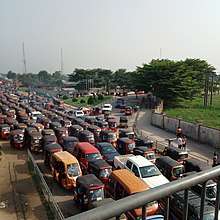
The auto rickshaw is used to provide transportation in cities all over Nigeria. Popularity and use varies across the country however. In Lagos, for example, the "keke" (Yoruba for bicycle) is regulated and transportation around the state's highways is prohibited.[14]
South Africa
.jpg)
Tuk-tuks, introduced in Durban[15] in the late 1980s enjoyed growing popularity in recent years, particularly in Gauteng.[16] In Cape Town they are used to deliver groceries and, more recently, transport tourists.[17][18]
Sudan
Rickshaws, known as "Raksha" in Sudan, is the most common mean of transportation followed by the bus in the capital Khartoum.
Tanzania
Rickshaws are locally known as "bajaji" and are a common mode of transportation in Dar es Salaam.[19]
Zimbabwe

Hende Moto Taxi were first introduced in Zimbabwe as the very first car manufactured by a Zimbabwean three wheeler manufacturing company Hende Moto Pvt Ltd, Hende Moto Engine in a Safari fiberglass body. The very first Hende Moto Taxi was introduced in Kwekwe August 2019, Zimbabwe and thereafter, Victoria Falls City came second and lastly Harare 2019. Hende Moto is also the manufacturer of the first Zimbabwean made electric passenger three wheeled vehicle. It operates on a lithium ion battery that has a range of 70 miles on a 6-hour charge.
South Asia
Afghanistan

Auto rickshaws are very common in the eastern Afghan city of Jalalabad, where they are popularly decorated in art and colors.[20] They are also popular in the northern city of Kunduz.[21]
Bangladesh

Auto rickshaws (locally called "baby taxis" and more recently "CNGs" due to their fuel source, compressed natural gas) are one of the more popular modes of transport in Bangladesh mainly due to their size and speed. They are best suited to narrow, crowded streets, and are thus the principal means of covering longer distances within urban areas.[22]
Two-stroke engines had been identified as one of the leading sources of air pollution in Dhaka. Thus, since January 2003, traditional auto rickshaws were banned from the capital; only the new natural gas-powered models (CNG) were permitted to operate within the city limits. All CNGs are painted green to signify that the vehicles are eco-friendly and that each one has a meter built-in.[23]
India
Most cities offer auto rickshaw service, although cycle rickshaws are also common and even hand-pulled rickshaws exist in certain areas such as Kolkata.[24]:15,57,156 In 2013 in Ranchi, the government launched an alternative rickshaw called the Pink Rickshaws to protect women against sexual assaults and rapes.[25]
Auto rickshaws are used in cities and towns for short distances; they are less suited to long distances because they are slow and the carriages are open to air pollution.[24]:57,58,110 Auto rickshaws (often called "autos") provide cheap and efficient transportation. Modern auto rickshaws run on compressed natural gas (CNG) and liquified petroleum gas (LPG) due to government regulations and are environmentally friendly compared to full-sized cars.[nb 1]
To augment speedy movement of traffic, auto rickshaws are not allowed in the southern part of Mumbai.[26]
India is the location of the annual Rickshaw Run.
There are two types of auto rickshaws in India. In older versions the engines were below the driver's seat, while in newer versions engines are in the rear. They normally run on petrol, CNG, or diesel. The seating capacity of a normal rickshaw is four, including the driver's seat. Six-seater rickshaws exist in different parts of the country, but the model was officially banned in the city of Pune on 10 January 2003 by the Regional Transport Authority (RTA).[27]
CNG autos in many cities (e.g. Delhi, Agra) are distinguishable from the earlier petrol-powered autos by a green and yellow livery, as opposed to the earlier black and yellow appearance. In other cities (such as Mumbai) the only distinguishing feature is the 'CNG' print found on the back or side of the auto. Some local governments are considering four-stroke engines instead of two-stroke versions.
Auto rickshaw manufacturers in India include Bajaj Auto, Atul Auto Limited, Kerala Automobiles Limited, Force Motors, Mahindra & Mahindra, Piaggio Ape, TVS Motors and Fleek Motors.
Besides conventional autos, in Delhi there also used to be a variant powered by a Harley-Davidson engine called the phat-phati, because of the characteristic—and quite loud—sound it made. The story goes that shortly after Independence a stock of Harley-Davidson motorbikes were found that had been used by British troops during World War II and left behind in a military storage house in Delhi. Some enterprising drivers purchased these bikes, added on a gear box (probably from a Willys jeep), welded on a passenger compartment that was good for four to six passengers, and put the highly unusual and unconventional vehicles onto the roads. A 1998 ruling of the Supreme Court against the use of polluting vehicles finally signed the death warrant of Delhi's phat-phatis.[28][29][30][31]
As of 2018 India has about 1.5 million battery-powered, three-wheeled rickshaws on its roads. Some 11,000 new ones hit the streets each month, creating a US$1.5 billion market. Manufacturers include Mahindra & Mahindra Ltd. and Kinetic Engineering. A hindrance to adoption to electric vehicles is the paucity of charging stations; India had only 425 at year-end 2017. By 2022 the number is projected to rise to 2,800.[32]
- Auto rickshaws at Pune Railway Station
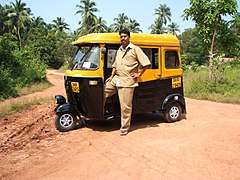 Auto rickshaw in Goa
Auto rickshaw in Goa TVS Auto rickshaw in Chennai
TVS Auto rickshaw in Chennai- CNG green auto rickshaw in Delhi
- An API 175 Lambretta Auto, no longer in production
Legislation
Generally rickshaw fares are controlled by the government,[33] however auto (and taxi) driver unions frequently go on strike demanding fare hikes. They have also gone on strike multiple times in Delhi to protest against the government and High Court's 2012 order to install GPS systems, and even though GPS installation in public transport was made mandatory in 2015, as of 2017 compliance remains very low.[34][35][36]
Nepal
Auto rickshaws were a popular mode of transport in Nepal during the 1980s and 1990s, until the government banned the movement of 600 such vehicles in the early 2000s.[37] The earliest auto rickshaws running in Kathmandu were manufactured by Bajaj Auto.
Nepal has been a popular destination for the Rickshaw Run. The 2009 Fall Run took place in Goa, India and ended in Pokhara, Nepal.[38]
Pakistan
Auto rickshaws are a popular mode of transport in Pakistani towns[39] and are mainly used for travelling short distances within cities. One of the major manufacturers of auto rickshaws is Piaggio. The government is taking measures to convert all gasoline powered auto rickshaws to cleaner CNG rickshaws by 2015 in all the major cities of Pakistan by issuing easy loans through commercial banks. Environment Canada is implementing pilot projects in Lahore, Karachi, and Quetta with engine technology developed in Mississauga, Ontario, Canada that uses CNG instead of gasoline in the two-stroke engines, in an effort to combat environmental pollution and noise levels.
In many cities in Pakistan, there are also motorcycle rickshaws, usually called "chand gari" (moon car) or "chingchi", after the Chinese company Jinan Qingqi Motorcycle Co. Ltd who first introduced these to the market.
There are many rickshaw manufacturers in Pakistan. Lahore is the hub of CNG auto rickshaw manufacturing. Manufacturers include: New Asia automobile Pvt, Ltd; AECO Export Company; STAHLCO Motors; Global Sources; Parhiyar Automobiles; Global Ledsys Technologies; Siwa Industries; Prime Punjab Automobiles; Murshid Farm Industries; Sazgar Automobiles; NTN Enterprises; and Imperial Engineering Company.
Sri Lanka
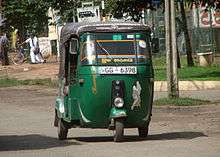
Auto rickshaws, commonly known as Three-wheelers, tuk-tuks (Sinhala: ටුක් ටුක්, pronounced [ṭuk ṭuk]) or trishaws can be found on all roads in Sri Lanka from the curvy roads in the hill country to the congested roads of Colombo transporting locals, foreigners, or freight about. Sri Lankan three-wheelers are of the style of the light Phnom Penh-type. Most of the three-wheelers in Sri Lanka are a slightly modified Indian Bajaj model, imported from India though there are few manufactured locally and increasingly imports from other countries in the region and other brands of three-wheelers such as Piaggio Ape. As of mid-2018, a new gasoline powered tuk-tuk typically costs around US$4,300, while a newly introduced Chinese electric model cost around US$5,900.[40] Since 2008, the Sri Lankan government has banned the import of all 2-stroke gasoline engines, due to environmental concerns.[40] Ones imported to the island now are four-stroke engines. Most three-wheelers are available as hired vehicles, with few being used to haul goods or as private company or advertising vehicles. Bajaj enjoys a virtual monopoly in the island, with its agent being David Pieries Motor Co, Ltd.[41] A few three-wheelers in Sri Lanka have distance meters. In the capital city it is becoming more and more common. The vast majority of fares are negotiated between the passenger and driver. There are 1.2 million trishaw's in Sri Lanka and most are on financial loans.
Southeast Asia
 Tuktuks and palmyra palms on the Mekong bank in Thakhek, Laos
Tuktuks and palmyra palms on the Mekong bank in Thakhek, Laos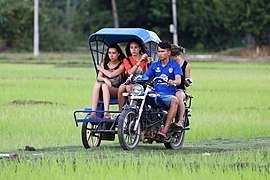 Tuk-tuk taxi sidecar in Laos
Tuk-tuk taxi sidecar in Laos- Tuk-tuk, Phnom Penh, Cambodia
Cambodia
In Cambodia, the term tuk-tuk (Khmer: ទុកទុក) refers may refer to a three-wheeled vehicle or to a passenger-carrying remorque pulled by a motorcycle. It is a widely used form of transportation in the capital of Phnom Penh and for visitors touring the Angkor temples in Siem Reap. Some have four wheels and is composed of a motorcycle (which leans) and trailer (which does not). Cambodian cities have a much lower volume of automobile traffic than Thai cities, and tuk-tuks are still the most common form of urban transport. There are more than 6,000 tuk-tuks in Phnom Penh, according to the Independent Democracy of Informal Economy Association (IDEA), a union that represents tuk-tuk drivers among other members.[42]
Indonesia
In Indonesia, auto rickshaws are popular in Jakarta as Bajay, Java, Medan and Gorontalo as Bentor, and some parts of Sulawesi and other places in the country. In Jakarta, the auto rickshaws are called Bajay or Bajaj and they are the same to as the ones in India but are colored blue (for the ones which use Compressed natural gas) and orange (for the ones which use normal gasoline fuel).[43] The blue ones are imported from India with the brand of Bajaj and TVS and the orange ones are the old design from 1990 and are not powered by gas like the blue ones, yet the government is increasing units of the blue Bajays and is step by step decreasing the orange bajays.[43] The Bajaj is one of the most popular modes of transportation in the city. Outside of Jakarta, the bentor-style auto rickshaw is ubiquitous, with the passenger cabin mounted as a sidecar (like in Medan) or in-front (like the ones in some parts of Sulawesi) to a motorcycle.
- Bentor in North Sumatra
- Bentor in Tana Toraja, South Sulawesi
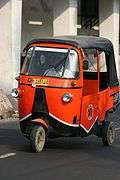 Gasoline fuelled Bajaj in Jakarta
Gasoline fuelled Bajaj in Jakarta CNG fuelled Bajaj in Jakarta.
CNG fuelled Bajaj in Jakarta.
Philippines
In the Philippines, a similar mode of public transport is the "tricycle" (Filipino: traysikel; Cebuano: traysikol).[44] Unlike auto rickshaws, however, it has a motorcycle with a sidecar configuration and a different origin. The exact date of its appearance in the Philippines is unknown, but it started appearing after World War 2, roughly at the same time as the appearance of the jeepney. It is most likely derived from the Rikuo Type 97 military motorcycle used by the Imperial Japanese Army in the Philippines starting at 1941. The motorcycle was essentially a licensed copy of a Harley-Davidson with a sidecar.[9] However, there is also another hypothesis which places the origin of the tricycle to the similarly built "trisikad", a human-powered cycle rickshaw built in the same configuration as the tricycle. However, the provenance of the trisikad is also unknown. Prior to the tricycles and trisikad, the most common means of mass public transport in the Philippines is a carriage pulled by horses or carabaos known as the kalesa (calesa or carromata in Philippine Spanish).[45] The pulled rickshaw never gained acceptance in the Philippines. Americans tried to introduce it in the early 20th century, but it was strongly opposed by local Filipinos who viewed it as an undignified mode of transport that turned humans into "beasts".[46]
The design and configuration of tricycles vary widely from place to place, but tends towards rough standardization within each municipality. The usual design is a passenger or cargo sidecar fitted to a motorbike, usually on the right of the motorbike. It is rare to find one with a left sidecar. A larger variant of the tricycle with the motorcycle in the center enclosed by a passenger cab with two side benches is known as a "motorela." It is found in the islands of Mindanao, Camiguin, and Bohol.[47] Another notable variant are the tricycles of the Batanes Islands which have cabs made from wood and roofed with thatched cogon grass.[48] In Pagadian City, tricycles are also uniquely built with the passenger cab slanting upwards, due to the city's streets that run along steep hills.[49]
Tricycles can carry three passengers or more in the sidecar, one or two pillion passengers behind the driver, and even a few on the roof of the sidecar. Tricycles are one of the main contributors to air pollution in the Philippines,[50][51] which account for 45% of all volatile organic compound (VOC) emissions[52] since majority of them employ two-stroke engines. However, some local governments are working towards phasing out two-stroke tricycles for ones with cleaner four-stroke engines.[50][53]
Tuk-tuks (which are still called tricycles locally despite having a completely different technical composition) and electric variants thereof are now seen in Philippine streets, especially in the city of Manila, called e-trikes, for the latter.[54] Combustion engine tuktuks are locally distributed by Bajaj Auto through dealerships[55]
- Motorized tricycle, Dumaguete City
- 7-passenger tricycle with large sidecar, Province of Aklan
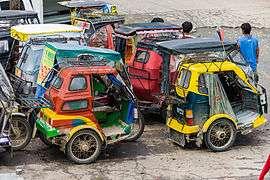 Tricycle stand, Banaue Municipal Town
Tricycle stand, Banaue Municipal Town
Thailand
The auto rickshaw, called tuk-tuk (Thai: ตุ๊ก ๆ, pronounced [túk túk]) in Thailand, is a widely used form of urban transport in Bangkok and other Thai cities. The name is onomatopoeic, mimicking the sound of a small (often two-cycle) engine. An equivalent English term would be "putt-putt". It is particularly popular where traffic congestion is a major problem, such as in Bangkok and Nakhon Ratchasima. Drivers may also use their tuk-tuks to transport fresh produce or other goods around the city in absence of passengers.
Bangkok and other cities in Thailand have many tuk-tuks which are a more open variation on the Indian auto rickshaw. About 20,000 tuk-tuks are registered as taxis in Thailand.[56] Bangkok alone is reported to have 9,000 tuk-tuks.[57]
Tuk-tuk hua kob (ตุ๊ก ๆ หัวกบ; literally: frog-headed tuk tuk) is a unique tuk tuk with a cab looking like a frog's head. Only Phra Nakhon Si Ayutthaya and Trang have vehicles like this.[58][59]
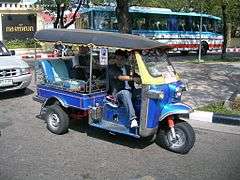 Tuk-tuk in Bangkok
Tuk-tuk in Bangkok Police tuk-tuk, Chiang Mai
Police tuk-tuk, Chiang Mai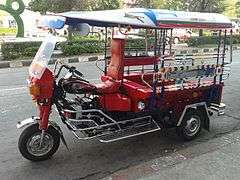
 Tuk-tuk hua kob, Phra Nakhon Si Ayutthaya
Tuk-tuk hua kob, Phra Nakhon Si Ayutthaya
East Asia
China
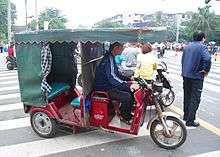
Various types of auto rickshaw are used around China, where they are called sān lún chē (三轮车) and sometimes sān bèng zǐ (三蹦子), meaning three wheeler or tricycle. They may be used to transport cargo or passengers in the more rural areas. However, in many urban areas the auto rickshaws for passengers are often operated illegally as they are considered unsafe and an eyesore.[60][61] They are permitted in some towns and cities, however. The Southeast Asian word tuk tuk is transliterated as dū dū chē (嘟嘟车, or beep beep car) in Chinese.[62]
Europe
France
A number of tuk-tuks (250 in 2013 according to the Paris Prefecture) are used as an alternative tourist transport system in Paris, some of them being pedal-operated with electric motor assist. They are not yet fully licensed to operate and await customers on the streets. Vélotaxis were common during the Occupation years in Paris due to fuel restrictions.[63]
Italy
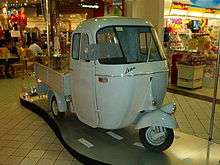
Auto rickshaws have been commonly used in Italy since the late 1940s, providing a low-cost means of transportation in the post–World War II years when the country was short of economic resources. The Piaggio Ape (Tukxi), designed by Vespa creator Corradino D'Ascanio and first manufactured in 1948 by the Italian company Piaggio, though primarily designed for carrying freight has also been widely used as an auto rickshaw. It is still extremely popular throughout the country, being particularly useful in the narrow streets found in the center of many little towns in central and southern Italy. Though it no longer has a key role in transportation, Piaggio Ape is still used as a minitaxi in some areas such as the islands of Ischia and Stromboli (on Stromboli no cars are allowed). It has recently been re-launched as a trendy-ecological means of transportation, or, relying on the role the Ape played in the history of Italian design, as a promotional tool. Since 2006 the Ape has been produced under licence in India.
Portugal

Tuk Tuks are used in the resort city of Albufeira in the Algarve as a novel form of transport for visitors during the tourist season.
United Kingdom
Tuk Tuks & Auto Rickshaws were introduced into the UK by Tukshop in 2004. Founded by mrsteve the first shipments of Bajaj vehicles arrived in Southampton where they were assembled and modified for UK road use.

In 2006 a British travel writer – Antonia Bolingbroke-Kent – and her friend Jo Huxster travelled 12,561 miles (20,215 km) with an auto rickshaw from Bangkok to Brighton. With this 98 days' trip they set a Guinness World Record for the longest journey ever with an auto rickshaw.
Central America
El Salvador
The mototaxi or moto is the El Salvadoran version of the auto rickshaw. These are most commonly made from the front end and engine of a motorcycle attached to a two-wheeled passenger area in back. Commercially produced models, such as the Indian Bajaj brand, are also employed.
Guatemala
In Guatemala tuk-tuks operate, both as taxis and private vehicles, in Guatemala City, around the island town of Flores, Peten, in the mountain city of Antigua Guatemala, and in many small towns in the mountains. In 2005 the tuk-tuks were prevalent in the Lago de Atitlán towns of Panajachel and Santiago Atitlán.
North America
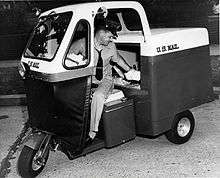
United States
In the 1950s and 1960s, the United States Post Office (replaced in 1971 by the United States Postal Service) used the WestCoaster Mailster, a close relative of the tuk-tuk.[64] Similar vehicles remain in limited use for parking enforcement, mall security, and other niche applications.
Cuba
In Cuba, the autorickshaws are small and look like a coconut, hence the name Cocotaxi.

Fuel efficiency and pollution
In July 1998, the Supreme Court of India ordered the Government of Delhi to implement CNG or LPG (Autogas) fuel for all autos and for the entire bus fleet in and around the city. Delhi's air quality has improved with the switch to CNG. Initially, auto rickshaw drivers in Delhi had to wait in long queues for CNG refueling, but the situation improved following an increase in the number of CNG stations. Gradually, many state governments passed similar laws, thus shifting to CNG or LPG vehicles in most large cities to improve air quality and reduce pollution. Certain local governments are pushing for four-stroke engines instead of two-stroke ones. Typical mileage for an Indian-made auto rickshaw is around 35 kilometres per litre (99 mpg‑imp; 82 mpg‑US) of petrol. Pakistan has passed a similar law prohibiting auto rickshaws in certain areas. CNG auto rickshaws have started to appear in huge numbers in many Pakistani cities.
In January 2007 the Sri Lankan government also banned two-stroke trishaws to reduce air pollution. In the Philippines[67] there are projects to convert carburated two-stroke engines to direct-injected via Envirofit technology. Research has shown LPG or CNG gas direct-injection can be retrofitted to existing engines, in similar fashion to the Envirofit system.[68] In Vigan City majority of tricycles-for-hire as of 2008 are powered by motorcycles with four-stroke engines, as tricycles with two-stroke motorcycles are prevented from receiving operating permits. Direct injection is standard equipment on new machines in India.[69][70]
In March 2009 an international consortium coordinated by the International Centre for Hydrogen Energy Technologies initiated a two-year public-private partnership of local and international stakeholders aiming at operating a fleet of 15 hydrogen-fueled three-wheeled vehicles in New Delhi's Pragati Maidan complex.[71] As of January 2011, the project was nearing completion.
Hydrogen internal combustion (HICV) use in three-wheelers has only recently being started to be looked into, mainly by developing countries, to decrease local pollution at an affordable cost.[72][73] At some point, Bajaj Auto made a HICV auto rickshaw together with the company "Energy Conversion Devices".[74] They made a report on it called "Clean Hydrogen Technology for 3-Wheel Transportation in India" and it stated that the performance was comparable with CNG autos. In 2012, Mahindra & Mahindra showcased their first HICV auto rickshaw, called the Mahindra HyAlfa.[74] The development of the hydrogen-powered rickshaw happened with support from the International Centre for Hydrogen Energy Technologies.
See also
- Fuel gas-powered scooter
- Formic acid vehicle: a type of hydrogen-based vehicle
- Jeepney
- Rickshaw (disambiguation)
Notes
- Typical fuel economy for an Indian-made auto rickshaw is around 35 kilometres per litre (99 mpg‑imp; 82 mpg‑US) of petrol.
References
- "Bajaj Auto in top gear". Fortune India.
- "Great Cars of Mazda: Mazda-Go 3-wheeled Trucks(1931~)". Mazda Motor Corporation. Archived from the original on 2019-02-09.
- ミゼット物語 木村信之 著 高原書店(Nobuyuki Kimura "Story of Midget", Published on 10 November 1998)
- Daihatsu Motor Co., Ltd. public relations section
- NPOみらいネットワーク寄附講座、ホテル観光学科の学生に日タイ関係をピーアール 日本での就職機会に関心. Bangkok Shuho (in Japanese). 2007-11-19. Archived from the original on 2009-04-30.
- /index.php?option=com_content&view=article&id=321:2009-11-30-05-34-59&catid=54:2009-09-09-07-52-31&Itemid=232 Royal Thai Embassy Tokyo, Japan 日本生まれのタイのトゥクトゥク (Tuk-Tuk of Thailand was born in Japan.)
- DESIAM.com: "Tuk-Tuk"
- "【ダイハツ ミゼット DKA / DSA型】 幌付3輪スクーター型トラック 旧式商用車図鑑". route0030.blog.fc2.com.
- "The History of the Philippines Tricycle". Brits in the Philippines. Retrieved 25 March 2020.
- "Tuk Tuks replace mules on Gaza streets,". Maan News Agency. 12 September 2010. Retrieved 2011-03-22.
- Jay Heale; Zawiah Abdul Latif (2008). Madagascar, Volume 15 of Cultures of the World Cultures of the World – Group 15 (2 ed.). Marshall Cavendish. pp. 75–76. ISBN 0761430369.
- Madagascar Travel Guide (7 ed.). Lonely Planet. 2012. ISBN 1743213018. Retrieved 2013-04-13.
- "'Bajaj' à Mahajanga : Entre 70 et 100 clients par jour". Midi Madagasikara (in French). 2014-05-30.
- Odunsi, Wale (16 November 2017). "Lagos bans okada, keke from 520 roads, areas [Full list]".
- "Durban offers beaches and culteral diversity". Zululand Tourism. Retrieved 22 September 2015.
Tuk Tuks: Mororised, covered tricycles which carry up to six passengers. Ideal for short 'hops' between the beachfront and city centre.
- Steyn, Lisa (18 January 2013). "Cheap-cheap tuk-tuk taxis take over Jozi". Retrieved 22 September 2015.
Tuk-tuks, also known as auto rickshaws, are becoming an increasingly common sight on South Africa's roads because people are trying to travel short distances at lower costs than driving and at less risk than walking.
- Ryan, Tamlyn (September 2016). "Tuk-tuks are coming to Cape Town". Inside Guide.
- Govender, Suthentira (2017-01-25). "Buddibox grocery delivery programme set to create 10,000 young entrepreneurs in Gauteng". Timeslive.
- Kalagho, Kenan (13 February 2012). "Tanzania: Bajaji, Dar es Salaam's Indispensable Taxi". AllAfrica. Retrieved 22 September 2015.
Until the year 2010 Dar es Salaam had no room for the Indian Bajaji and or a tricycle to be used as a means of transporting passengers. Today it is a common feature around Dar es Salaam.
- https://www.irishtimes.com/news/world/asia-pacific/in-taliban-country-inside-the-city-of-jalalabad-1.1674001
- https://www.pajhwok.com/en/2012/05/23/auto-rickshaws-clogging-kunduz-arteries
- Lane, Jo. "Asia's love affair with the rickshaw". asiancorrespondent.com. asiancorrespondent.com. Retrieved 2015-07-30.
- "Police purge for Dhaka rickshaws". BBC News. 20 December 2002. Retrieved 2011-03-22.
- Pippa de Bruyn; Keith Bain; David Allardice; Shonar Joshi (2010). Frommer's India (Fourth ed.). John Wiley and Sons. ISBN 0470645806.
- "PINK AUTO RICKSHAW PROJECT" (PDF). July 17, 2019.
- Pippa de Bruyn; Keith Bain; David Allardice; Shonar Joshi (2010). Frommer's India (Fourth ed.). John Wiley and Sons. p. 110. ISBN 0470645806.
- "Six seater rickshaws banned in city". Times of India. 25 September 2003. Retrieved 2014-01-11.
- "Remembering Delhi's phat-phatis – Times of India".
- "Transportation through the ages in Shahjahanabad".
- "The Phatphatis of Delhi". 23 September 2011.
- "Phat Phatis of Delhi – Toothless Blog – MouthShut.com". www.mouthshut.com.
- Ward, Jill; Upadhyay, Anindya (26 October 2018). "India's Rickshaw Revolution Leaves China in the Dustina in dust". Bloomberg. Retrieved 28 October 2018.
- "Maharashtra Govt refuses to increase autorickshaw, taxi fares". newKerala.com. UNI. Archived from the original on 2013-05-18.
- "Autos, taxis in Delhi to go on strike today demanding fare hike". India Today. 15 October 2012. Retrieved 2017-02-19.
- "Delhi High Court Directs City Auto-Rickshaws To Install GPS". Medianama. 28 September 2012. Retrieved 2017-02-19.
- "GPS installation in public transport becomes mandatory". Times of India. 2 June 2015. Retrieved 2017-02-19.
- "Nepal Government decides to ban 3 wheeler auto rickshaws from Nepal's road". BBC. 28 July 1999. Retrieved 2011-12-06.
- "Rickshaw Run on 3 Wheelers from Goa, India to Pokhara, Nepal". The National. 29 August 2009. Retrieved 2011-12-06.
- Sebastian Abbot, Associated Press (8 February 2013). "Eye-Catching Rickshaws Promote Peace in Pakistan". ABC News. Retrieved 2013-04-13.
- Ranasinghe, A.K. (3 September 2018). "Can He Convince Sri Lankan Tuk-Tuk Owners to Go Green?". OZY. Retrieved 3 September 2018.
Tuk-tuks play a vital role in urban Sri Lanka's passenger transport system, providing what traffic experts call "last mile" service. Police and government workers rely on them too to navigate congested streets. In rural Sri Lanka, they are everything from taxi to ambulance.
- "Bajaj ready with 4-stroke autos for SL". Indiacar.net. Archived from the original on 2009-06-27. Retrieved 2010-04-03.
- WILKINS, Emily (19 February 2014). "New Futuristic Tuk-Tuks Arrive on the Streets of Phnom Penh". The Cambodia Daily. Retrieved 30 January 2015.
- "Bajaj Oranye Menunggu Giliran Dimusnahkan". Republika Online (in Indonesian). 7 January 2016. Retrieved 26 May 2018.
- "Motorcycles and tricycles". Utrecht Faculty of Education. Archived from the original on 7 March 2009. Retrieved 2009-03-14.
- "Filipino Icon: Tricycle and Pedicab". FFE Magazine. 29 December 2016. Retrieved 25 March 2020.
- Pante, Michael D. (14 August 2014). "Rickshaws and Filipinos: Transnational Meanings of Technology and Labor in American-Occupied Manila". International Review of Social History. 59 (S22): 133–159. doi:10.1017/S0020859014000315.
- "Tricycle, Motorela & Habal-Habal". Silent Gardens. Retrieved 25 March 2020.
- Corsino, Nikka (24 October 2013). "A day on Sabtang Island in Batanes". GMA News Online. Retrieved 25 March 2020.
- "WATCH: What makes Pagadian tricycles unique". Rappler. 23 January 2017. Retrieved 25 March 2020.
- "Tricycles in the Philippines". cleanairasia.org. Retrieved 7 January 2019.
- Taruc, Paolo (25 March 2015). "Tricycles: As iconic as jeepneys and just as problematic". CNN Philippines. Retrieved 7 January 2019.
- Felongco, Gilbert P. (22 November 2015). "Philippines: Tricycles and motorcycles responsible for 45 per cent of harmful emissions". Gulf News. Retrieved 7 January 2019.
- "Mandaluyong City 2-Stroke Replacement Project". cleanairasia.org. Retrieved 7 January 2019.
- "E.R.A.P. Manila electric tricycle project – Second batch of beneficiaries ready". www.bemac-philippines.com.
- "Bajaj RE Philippines Tuk-Tuk (Auto Rickshaw)". Brits in the Philippines. 25 January 2018.
- Wattanasukchai, Sirinya (2 February 2017). "With our tuk tuks, let's copy the Dutch". Bangkok Post. Retrieved 2 February 2017.
- "Thailand government says Bangkok has too many 'tuk-tuks'". Asian Correspondent. 2016-04-15. Retrieved 2016-04-15.
- "Frog-headed Tuk Tuk, Symbol of Aytthaya". Go Ayutthaya. Retrieved 2019-05-30.
- MUANGKAEW, METHEE (2013-02-19). "Tuk-tuk 'endangered species' in Trang". Bangkok Post. Retrieved 2019-05-30.
- "明珠路上规模浩大的等客车队 危险逆行载客". 珠江晚报. 3 November 2009. Archived from the original on 2015-04-04.
- "[天津]面对"三蹦子" 请您大声说"不"". auto sohu.
- "東南亞的三輪車". Global Voices. 25 March 2012.
- "A Paris, les tuk-tuks fleurissent... tout comme les PV". La Dépêche (in French). Toulouse. AFP. 2013-08-20.
- "National Postal Museum". 25 August 2009. Archived from the original on 25 August 2009.
- http://www.peru-motor.com/motocar/
- Tony Dunnell (28 July 2017). "A Traveler's Guide to Mototaxis in Peru". tripsavvy. Retrieved 27 November 2017.
- "Envirofit's Tricycle Retrofit Program Funded". Colorado State University. 19 May 2006. Archived from the original on 29 September 2011. Retrieved 2011-03-22.
- "Microsoft Word – SETC_LPG2T.doc" (PDF). Retrieved 2010-04-03.
- "Bajaj rolls out low-emission fuel-efficient autorickshaw". Business Line. The Hindu. 2007-12-09. Retrieved 2010-04-03.
- "Bajaj Begins Production of 2-Stroke Direct-Injection Auto Rickshaw". Green Car Congress. 2007-05-18. Retrieved 2010-04-03.
- "A fleet of hydrogen rickshaws to circulate in New Delhi by 2010". International Centre for Hydrogen Energy Technologies. Archived from the original on 2011-07-28. Retrieved 2011-03-22.
- Hydrogen-Fueled Internal Combustion Engines, see page 7
- Clean Hydrogen Technology for 3-Wheel Transportation in India
- India Showcases Hydrogen Fuel Auto-Rickshaws
External links
| Wikimedia Commons has media related to Auto-rickshaws. |
- The India 1000 – an article in Wired about auto rickshaw racing

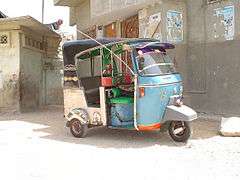

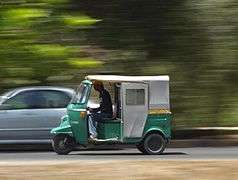
.jpg)
.jpg)
